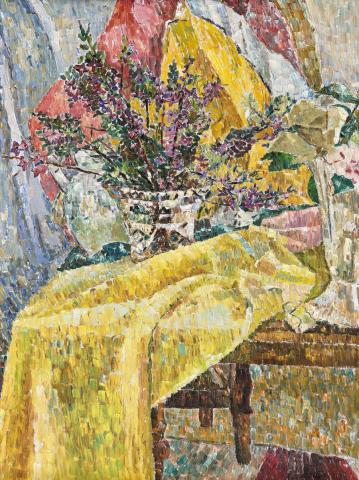STILL LIFE WITH BORONIA, 1955
GRACE COSSINGTON SMITH
oil on pulpboard
67.0 x 49.5 cm
signed and dated lower right: G. Cossington Smith 55
signed and inscribed on label verso: Still Life with Boronia / Grace Cossington Smith / ... 1955
The Estate of The Lady Casey, Melbourne
Grace Cossington Smith is a painter of light suffused with colour. It is the light of this world as well as a metaphor of enlightenment. 'My chief interest, [she said], ... has always been colour, but not flat crude colour, it must be colour within colour, it has to shine; light must be in it ...'1 Smith's still life paintings are not only an expression of the enjoyment of the visual world but also an exploration of the spiritual found in the everyday. Still Life with Boronia, 1955 is a classic example. It sparkles with light and colour, especially yellow, 'the colour of the sun', as she described it.2 Yellow often features in her paintings - the flow of a yellow cloth, a jug or cup " the shine of light coming from polished and glazed surfaces, glass, or reflections from water. And she fills these simplest of objects with a depth and profundity that is moving. What could be more prosaic than the subject of Things on an Iron Tray on the Floor, c.1927 in the collection of the Art Gallery of New South Wales? Yet, through her handling of form and colour she transforms it into something poetic. It is the same with landscapes, Landscape with Flowering Peach, c.1933 in the Shepparton Art Gallery, Victoria, for example, being a nuanced essay on the beauty of pink in harmony with sister hues.
In Still Life with Boronia, yellow cascades down the picture plane, which is enlivened by all the individual stokes of pure colour, juxtaposed and contrasted. It is like a mosaic in paint; but unlike a mosaic in that the light is not reflected but comes from within. Moreover, while one can readily discern the flowers, vases, table and chair that make up the figurative elements of the picture, the overall effect verges on the abstract. It embraces harmony and evokes a visual hymn of praise, the vibrancy of the paintwork stilled only by the serenity of its inner tranquillity. The seeming simplicity of concept and response, one of those marvellous paradoxes of creativity, is wedded to an intimacy that invites participation and admiration. Writing many years ago, Ethel Anderson said of her work, 'Miss Grace Cossington Smith's pictures have the cool elegance of hail, or of cherry blossoms after a spring shower. They are high-pitched and clear ... And they are all happy pictures. Miss Cossington Smith seems to paint for no other reason than to express her pleasure in life.'3 Although outwardly of furniture and flowers, they are essays of enjoyment, to be shared with the viewer.
1. The artist in conversation with Hazel de Berg, 16 August 1965, National Library of Australia, quoted in Modjeska, D., Stravinsky's Lunch, Picador, Pan Macmillan Australia, Sydney 1999, p. 227
2. Modjeska, D., op. cit., p. 225
3. Anderson, E., 'Happy pictures by a young Australian artist', Walkers Monthly, London, April 1932, quoted in Thomas, D., Grace Cossington Smith, Art Gallery of New South Wales, Sydney, 1973, p. 7
DAVID THOMAS
